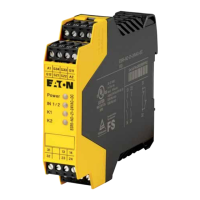IM02602002E
www.eaton.com Page 5-11
MP-3000
P12L16 selects the action to take if any of the MP-3000 internal back-
ground self-monitoring programs detect a problem with the relay. The
factory setting is to trip and alarm. However, users with critical pro-
cesses may prefer to set for alarm only so that the motor can continue
to run while maintenance personnel attend to the relay.
-
.
P12L17 selects whether or not the MP-3000 accepts and executes a motor
trip command from a remote PowerNet or IMPACC operator via data com-
munications. This is dictated by security concerns and operating proce-
dures of users who connect the MP-3000 to a facility control system.
This maintenance function blocks the MP-3000 trip output, while all
the tripping functions continue to operate internally. If DISARMED is
selected, the MP-3000 still displays all alarms and trips, but the trip
output relay contact remains in its non-tripped state.
For safety purposes when the unit is DISARMED, the MP-3000 scrolls
a warning message “WARNING MP-3000 WILL BE DISARMED UPON
EXIT OF PROGRAM MODE AND WILL NOT PROTECT THE MOTOR
- ENTER ARMED INTO SETTING TO PROTECT THE MOTOR”. The
default display reads DISARMED, and the Protection LED turns off.
Any alarm or trip messages on the display alternate with the word
DISARMED.
In the ARMED mode, the MP-3000 works normally. The DISARMED
mode is useful for commissioning a new relay or new settings on a
running motor, when a false trip output would disrupt the process. The
User can commission the MP-3000 in the DISARMED mode and ob-
serve its behavior, noting any trip operations or lling of the
I2t thermal
bucket without suffering the consequence of an undesired trip. Once
the User conrms that the settings are suitable, set the MP-3000 to
ARMED and true protection is enabled.
The ALARM, AUX1, and AUX2 output contacts all function
normally, even when the MP-3000 is DISARMED.
To get the full use of the DISARMED/ARMED capability of the
MP-3000, be sure to set P12L6 to RUN PGM (allow the MP-
3000 to be programmed while the motor runs), so that the relay
can be armed without stopping the motor.
.
Page 13 is used to test the MP-3000.
This function allows the MP-3000 to be bench-tested using a single-
phase current source (1 PHASE) if a 3-phase source is unavailable
at the test bench. The phase unbalance functions cannot be tested
in 1 PHASE mode. For three-phase testing and all normal operation,
select the three-phase mode (3 PHASE).
-
.
P13L2 permits the User to directly energize or de-energize the trip
relay for testing purposes. To use this function:
Stop the motor rst. The test is blocked if the motor is running.
Determine whether the MP-3000 trip relay is congured for MODE 1 or
MODE 2 operation. Refer to Setting P12L1 in Subsection 5.12.1.
If MODE 1, the trip relay is normally de-energized. Set up for the test
by selecting TRP ENER here.
If MODE 2, the trip relay is normally energized. Set up for the test by
selecting TRP DENR here.
Press the Reset button to test the relay. The Trip LED also lights.
Release the button to revert to the prior output state.
P13L3 lets the User directly energize or de-energize the alarm relay
for testing purposes. Use it in the same way as the trip relay test.
Check the Alarm relay MODE Setting P12L2. Unlike the trip output,
this output can be tested with the motor running.
P13L4 permits the User to directly energize or de-energize the AUX1
relay for testing purposes. Use it in the same way as the trip relay
test. Check the AUX1 relay MODE Setting P12L3. Unlike the trip
output, this output can be tested with the motor running.
Lets the User directly energize or de-energize the AUX2 relay for test-
ing purposes. Use it in the same way as the trip relay test. Check the
AUX2 relay MODE Setting P12L4. Unlike the trip output, this output
can be tested with the motor running.
To test the analog output, rst select the value to force - either 4, 12,
or 20 mA. When ready to test, push and hold the Reset button to
observe the forced output value. When the Reset button is released,
the analog output returns to normal operation.
